CHEVROLET KODIAK 2004 Service Manual
Manufacturer: CHEVROLET, Model Year: 2004, Model line: KODIAK, Model: CHEVROLET KODIAK 2004Pages: 366, PDF Size: 6.87 MB
Page 41 of 366
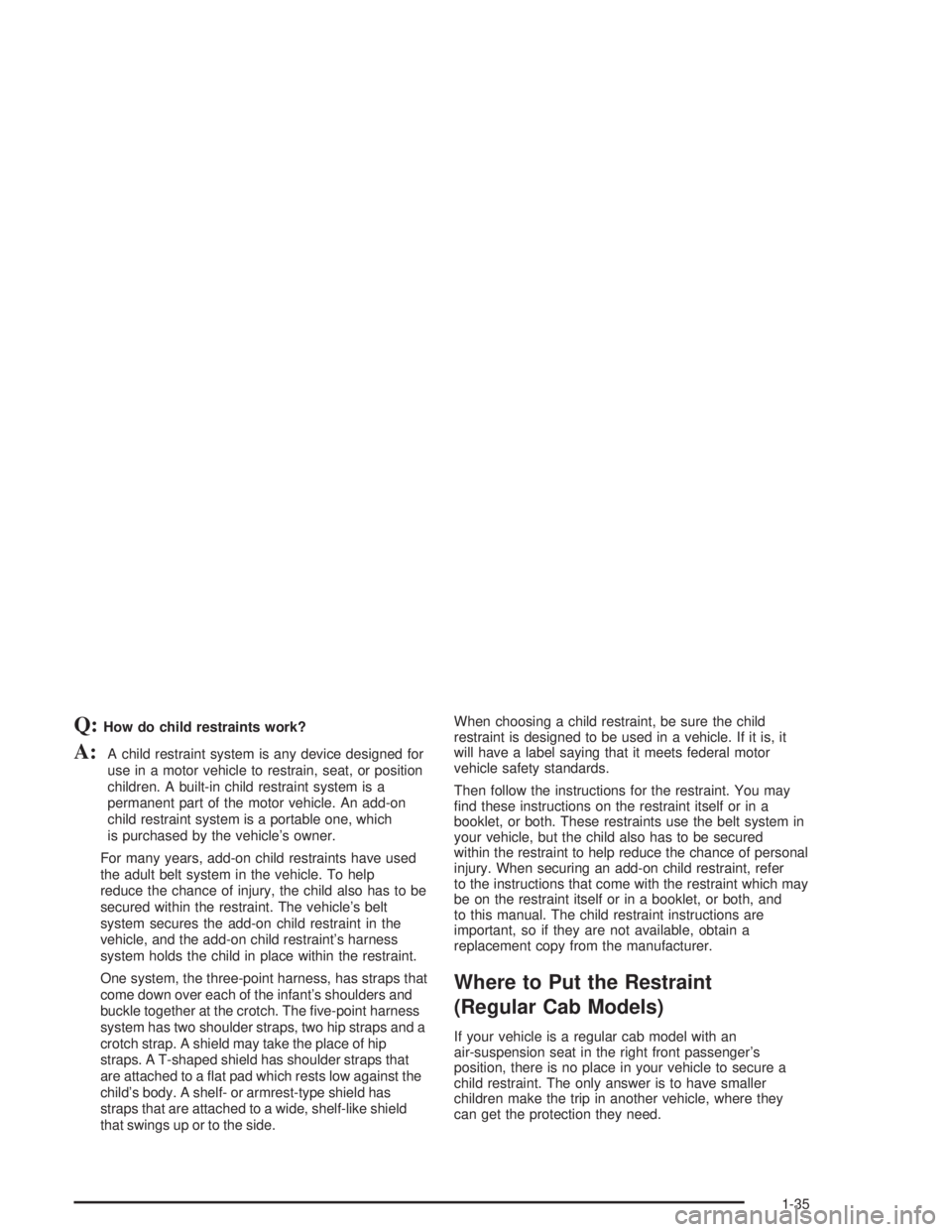
Q:How do child restraints work?
A:A child restraint system is any device designed for
use in a motor vehicle to restrain, seat, or position
children. A built-in child restraint system is a
permanent part of the motor vehicle. An add-on
child restraint system is a portable one, which
is purchased by the vehicle’s owner.
For many years, add-on child restraints have used
the adult belt system in the vehicle. To help
reduce the chance of injury, the child also has to be
secured within the restraint. The vehicle’s belt
system secures the add-on child restraint in the
vehicle, and the add-on child restraint’s harness
system holds the child in place within the restraint.
One system, the three-point harness, has straps that
come down over each of the infant’s shoulders and
buckle together at the crotch. The five-point harness
system has two shoulder straps, two hip straps and a
crotch strap. A shield may take the place of hip
straps. A T-shaped shield has shoulder straps that
are attached to a flat pad which rests low against the
child’s body. A shelf- or armrest-type shield has
straps that are attached to a wide, shelf-like shield
that swings up or to the side.When choosing a child restraint, be sure the child
restraint is designed to be used in a vehicle. If it is, it
will have a label saying that it meets federal motor
vehicle safety standards.
Then follow the instructions for the restraint. You may
find these instructions on the restraint itself or in a
booklet, or both. These restraints use the belt system in
your vehicle, but the child also has to be secured
within the restraint to help reduce the chance of personal
injury. When securing an add-on child restraint, refer
to the instructions that come with the restraint which may
be on the restraint itself or in a booklet, or both, and
to this manual. The child restraint instructions are
important, so if they are not available, obtain a
replacement copy from the manufacturer.
Where to Put the Restraint
(Regular Cab Models)
If your vehicle is a regular cab model with an
air-suspension seat in the right front passenger’s
position, there is no place in your vehicle to secure a
child restraint. The only answer is to have smaller
children make the trip in another vehicle, where they
can get the protection they need.
1-35
Page 42 of 366
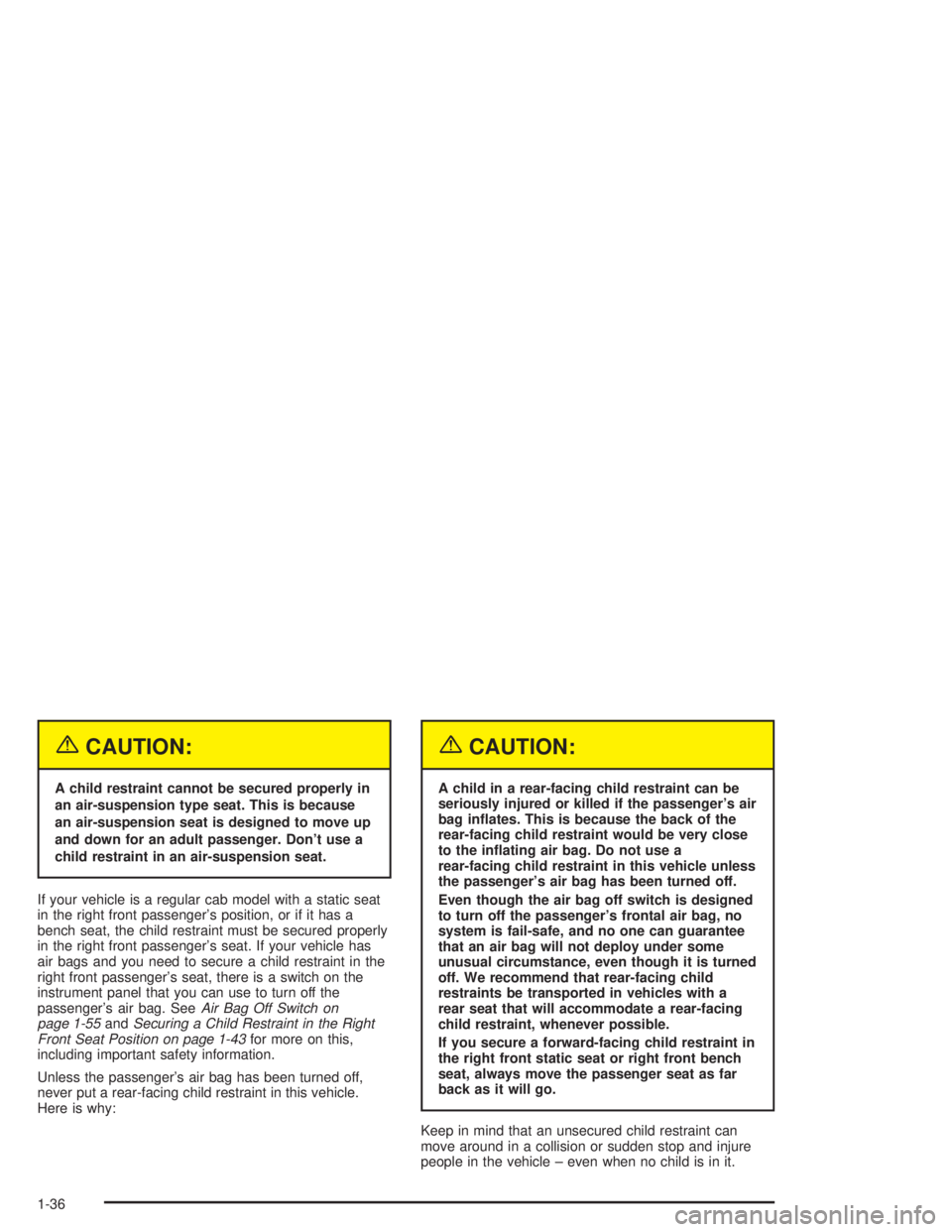
{CAUTION:
A child restraint cannot be secured properly in
an air-suspension type seat. This is because
an air-suspension seat is designed to move up
and down for an adult passenger. Don’t use a
child restraint in an air-suspension seat.
If your vehicle is a regular cab model with a static seat
in the right front passenger’s position, or if it has a
bench seat, the child restraint must be secured properly
in the right front passenger’s seat. If your vehicle has
air bags and you need to secure a child restraint in the
right front passenger’s seat, there is a switch on the
instrument panel that you can use to turn off the
passenger’s air bag. SeeAir Bag Off Switch on
page 1-55andSecuring a Child Restraint in the Right
Front Seat Position on page 1-43for more on this,
including important safety information.
Unless the passenger’s air bag has been turned off,
never put a rear-facing child restraint in this vehicle.
Here is why:
{CAUTION:
A child in a rear-facing child restraint can be
seriously injured or killed if the passenger’s air
bag in�ates. This is because the back of the
rear-facing child restraint would be very close
to the in�ating air bag. Do not use a
rear-facing child restraint in this vehicle unless
the passenger’s air bag has been turned off.
Even though the air bag off switch is designed
to turn off the passenger’s frontal air bag, no
system is fail-safe, and no one can guarantee
that an air bag will not deploy under some
unusual circumstance, even though it is turned
off. We recommend that rear-facing child
restraints be transported in vehicles with a
rear seat that will accommodate a rear-facing
child restraint, whenever possible.
If you secure a forward-facing child restraint in
the right front static seat or right front bench
seat, always move the passenger seat as far
back as it will go.
Keep in mind that an unsecured child restraint can
move around in a collision or sudden stop and injure
people in the vehicle – even when no child is in it.
1-36
Page 43 of 366
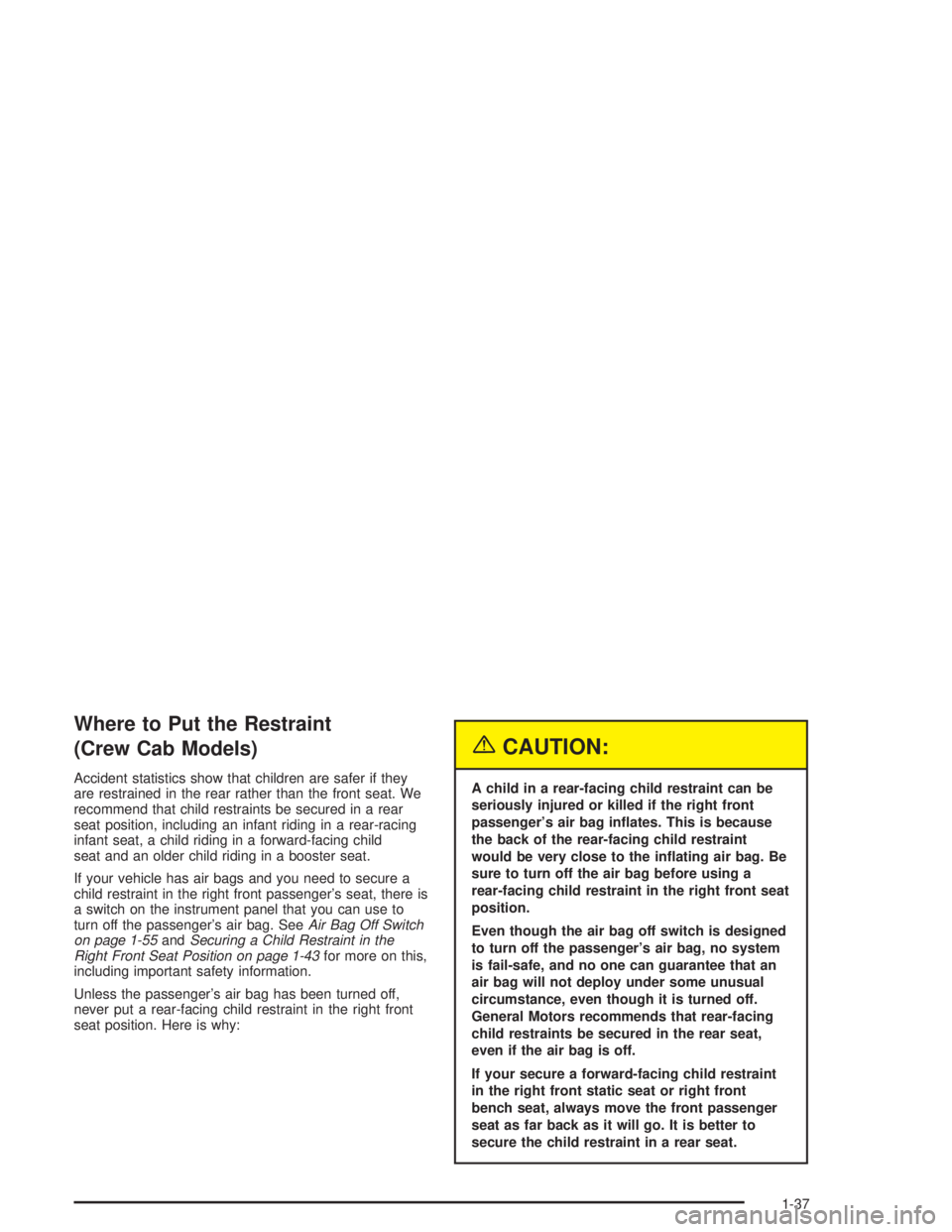
Where to Put the Restraint
(Crew Cab Models)
Accident statistics show that children are safer if they
are restrained in the rear rather than the front seat. We
recommend that child restraints be secured in a rear
seat position, including an infant riding in a rear-racing
infant seat, a child riding in a forward-facing child
seat and an older child riding in a booster seat.
If your vehicle has air bags and you need to secure a
child restraint in the right front passenger’s seat, there is
a switch on the instrument panel that you can use to
turn off the passenger’s air bag. SeeAir Bag Off Switch
on page 1-55andSecuring a Child Restraint in the
Right Front Seat Position on page 1-43for more on this,
including important safety information.
Unless the passenger’s air bag has been turned off,
never put a rear-facing child restraint in the right front
seat position. Here is why:
{CAUTION:
A child in a rear-facing child restraint can be
seriously injured or killed if the right front
passenger’s air bag in�ates. This is because
the back of the rear-facing child restraint
would be very close to the in�ating air bag. Be
sure to turn off the air bag before using a
rear-facing child restraint in the right front seat
position.
Even though the air bag off switch is designed
to turn off the passenger’s air bag, no system
is fail-safe, and no one can guarantee that an
air bag will not deploy under some unusual
circumstance, even though it is turned off.
General Motors recommends that rear-facing
child restraints be secured in the rear seat,
even if the air bag is off.
If your secure a forward-facing child restraint
in the right front static seat or right front
bench seat, always move the front passenger
seat as far back as it will go. It is better to
secure the child restraint in a rear seat.
1-37
Page 44 of 366
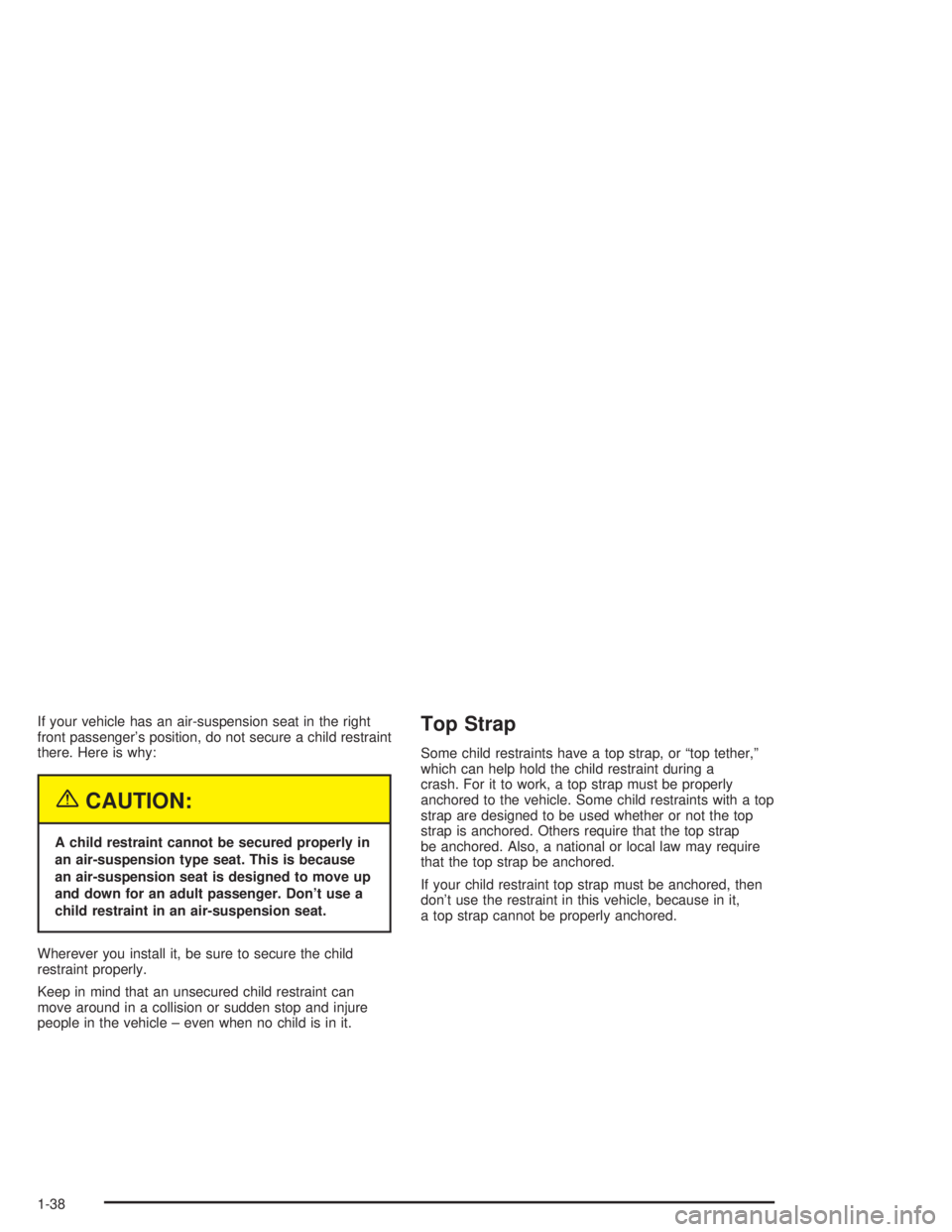
If your vehicle has an air-suspension seat in the right
front passenger’s position, do not secure a child restraint
there. Here is why:
{CAUTION:
A child restraint cannot be secured properly in
an air-suspension type seat. This is because
an air-suspension seat is designed to move up
and down for an adult passenger. Don’t use a
child restraint in an air-suspension seat.
Wherever you install it, be sure to secure the child
restraint properly.
Keep in mind that an unsecured child restraint can
move around in a collision or sudden stop and injure
people in the vehicle – even when no child is in it.
Top Strap
Some child restraints have a top strap, or “top tether,”
which can help hold the child restraint during a
crash. For it to work, a top strap must be properly
anchored to the vehicle. Some child restraints with a top
strap are designed to be used whether or not the top
strap is anchored. Others require that the top strap
be anchored. Also, a national or local law may require
that the top strap be anchored.
If your child restraint top strap must be anchored, then
don’t use the restraint in this vehicle, because in it,
a top strap cannot be properly anchored.
1-38
Page 45 of 366
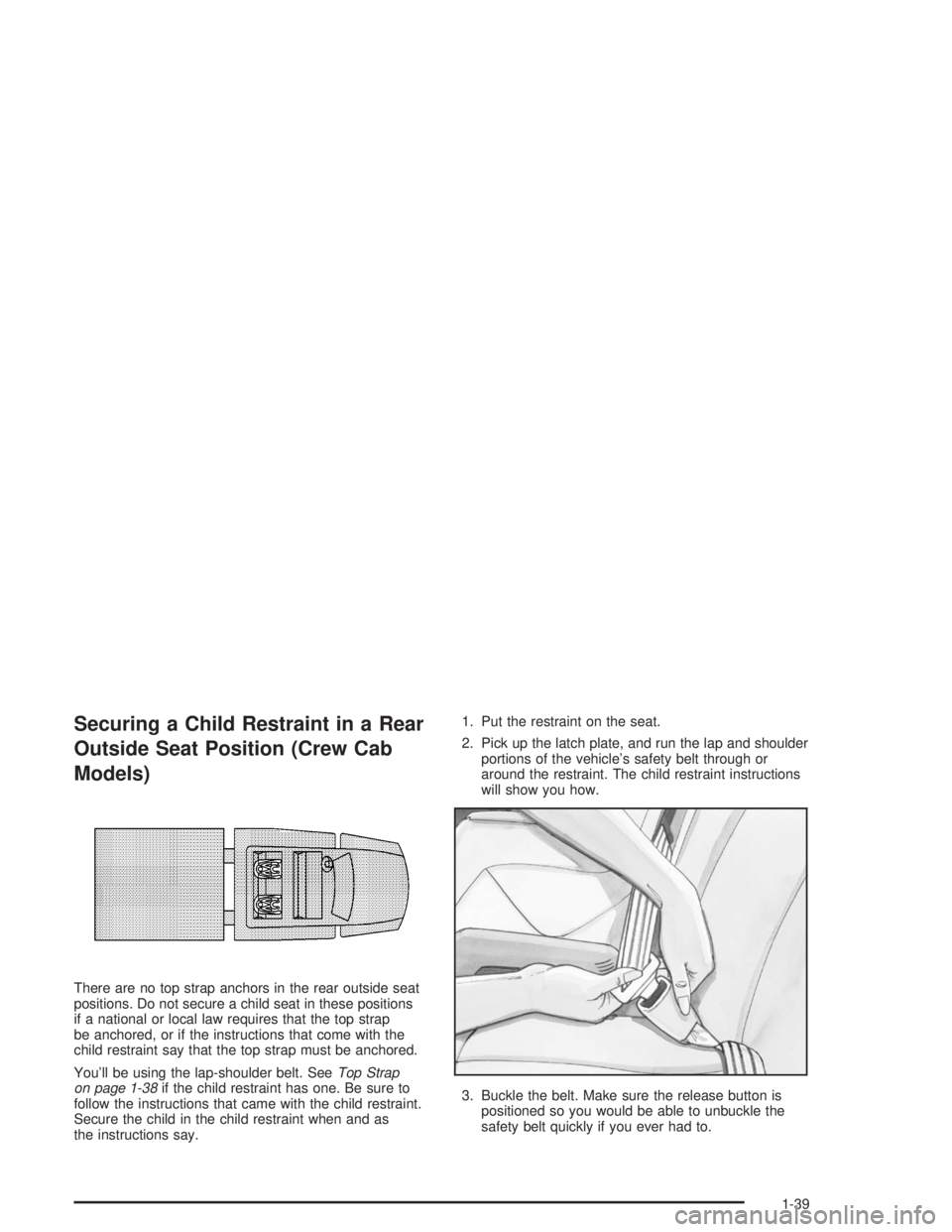
Securing a Child Restraint in a Rear
Outside Seat Position (Crew Cab
Models)
There are no top strap anchors in the rear outside seat
positions. Do not secure a child seat in these positions
if a national or local law requires that the top strap
be anchored, or if the instructions that come with the
child restraint say that the top strap must be anchored.
You’ll be using the lap-shoulder belt. SeeTop Strap
on page 1-38if the child restraint has one. Be sure to
follow the instructions that came with the child restraint.
Secure the child in the child restraint when and as
the instructions say.1. Put the restraint on the seat.
2. Pick up the latch plate, and run the lap and shoulder
portions of the vehicle’s safety belt through or
around the restraint. The child restraint instructions
will show you how.
3. Buckle the belt. Make sure the release button is
positioned so you would be able to unbuckle the
safety belt quickly if you ever had to.
1-39
Page 46 of 366
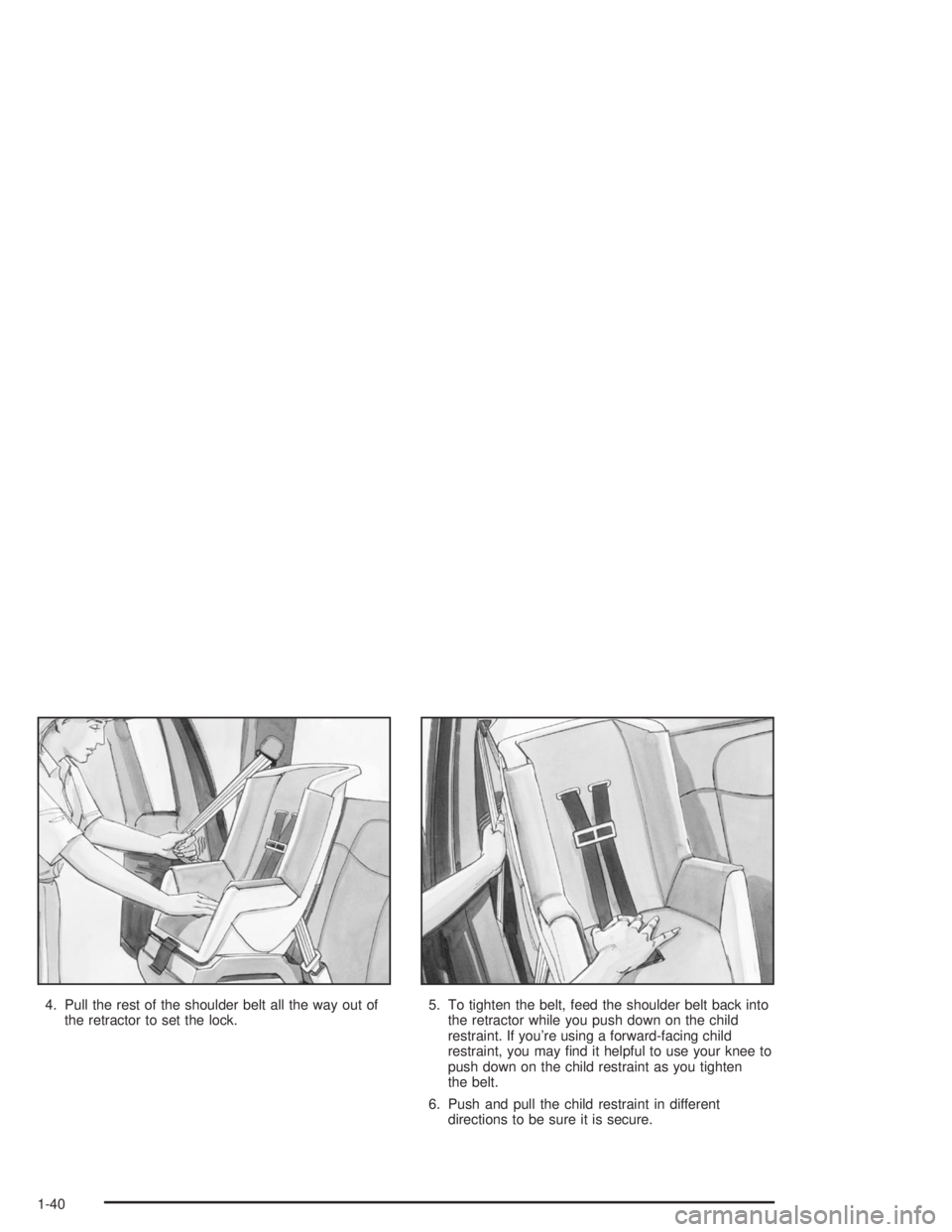
4. Pull the rest of the shoulder belt all the way out of
the retractor to set the lock.5. To tighten the belt, feed the shoulder belt back into
the retractor while you push down on the child
restraint. If you’re using a forward-facing child
restraint, you may find it helpful to use your knee to
push down on the child restraint as you tighten
the belt.
6. Push and pull the child restraint in different
directions to be sure it is secure.
1-40
Page 47 of 366
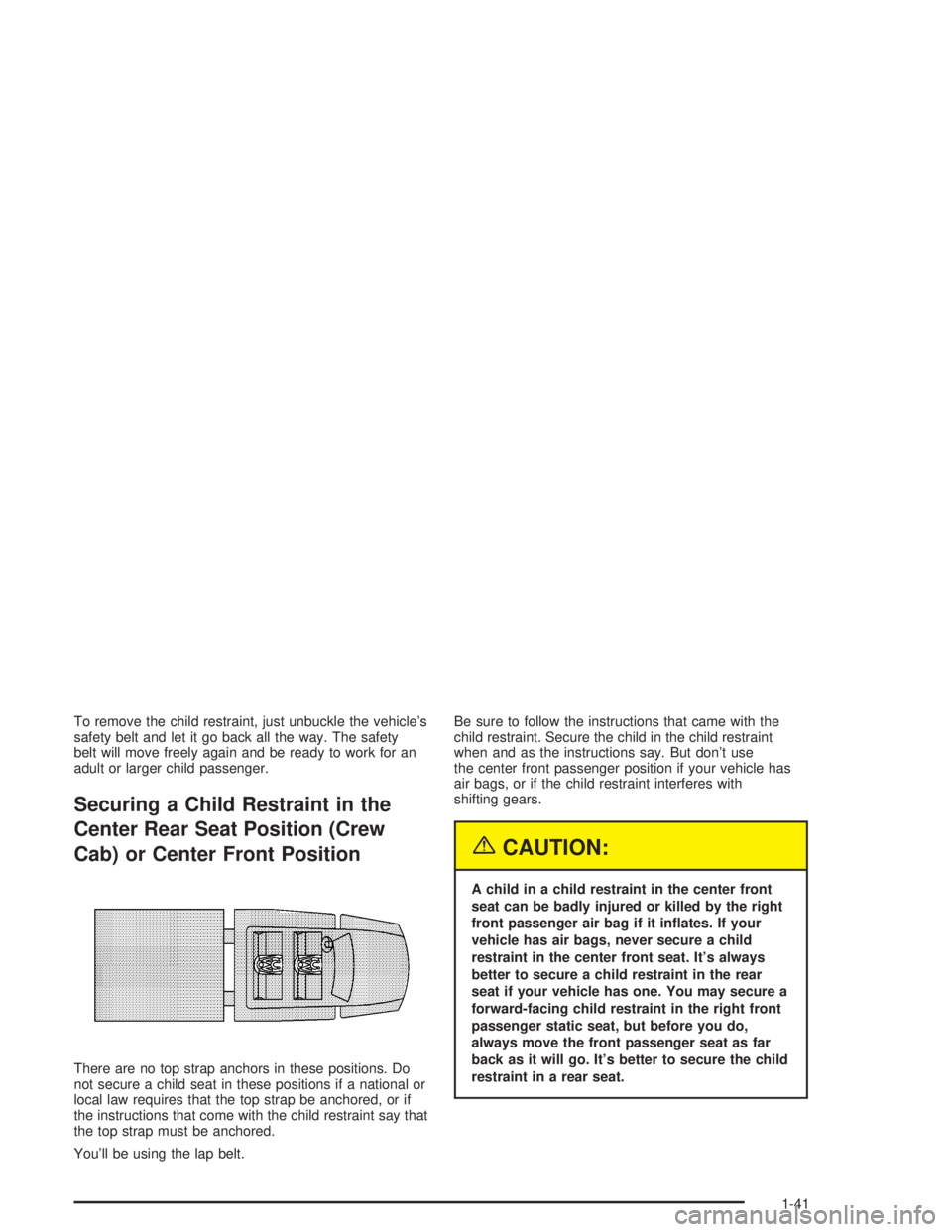
To remove the child restraint, just unbuckle the vehicle’s
safety belt and let it go back all the way. The safety
belt will move freely again and be ready to work for an
adult or larger child passenger.
Securing a Child Restraint in the
Center Rear Seat Position (Crew
Cab) or Center Front Position
There are no top strap anchors in these positions. Do
not secure a child seat in these positions if a national or
local law requires that the top strap be anchored, or if
the instructions that come with the child restraint say that
the top strap must be anchored.
You’ll be using the lap belt.Be sure to follow the instructions that came with the
child restraint. Secure the child in the child restraint
when and as the instructions say. But don’t use
the center front passenger position if your vehicle has
air bags, or if the child restraint interferes with
shifting gears.
{CAUTION:
A child in a child restraint in the center front
seat can be badly injured or killed by the right
front passenger air bag if it in�ates. If your
vehicle has air bags, never secure a child
restraint in the center front seat. It’s always
better to secure a child restraint in the rear
seat if your vehicle has one. You may secure a
forward-facing child restraint in the right front
passenger static seat, but before you do,
always move the front passenger seat as far
back as it will go. It’s better to secure the child
restraint in a rear seat.
1-41
Page 48 of 366
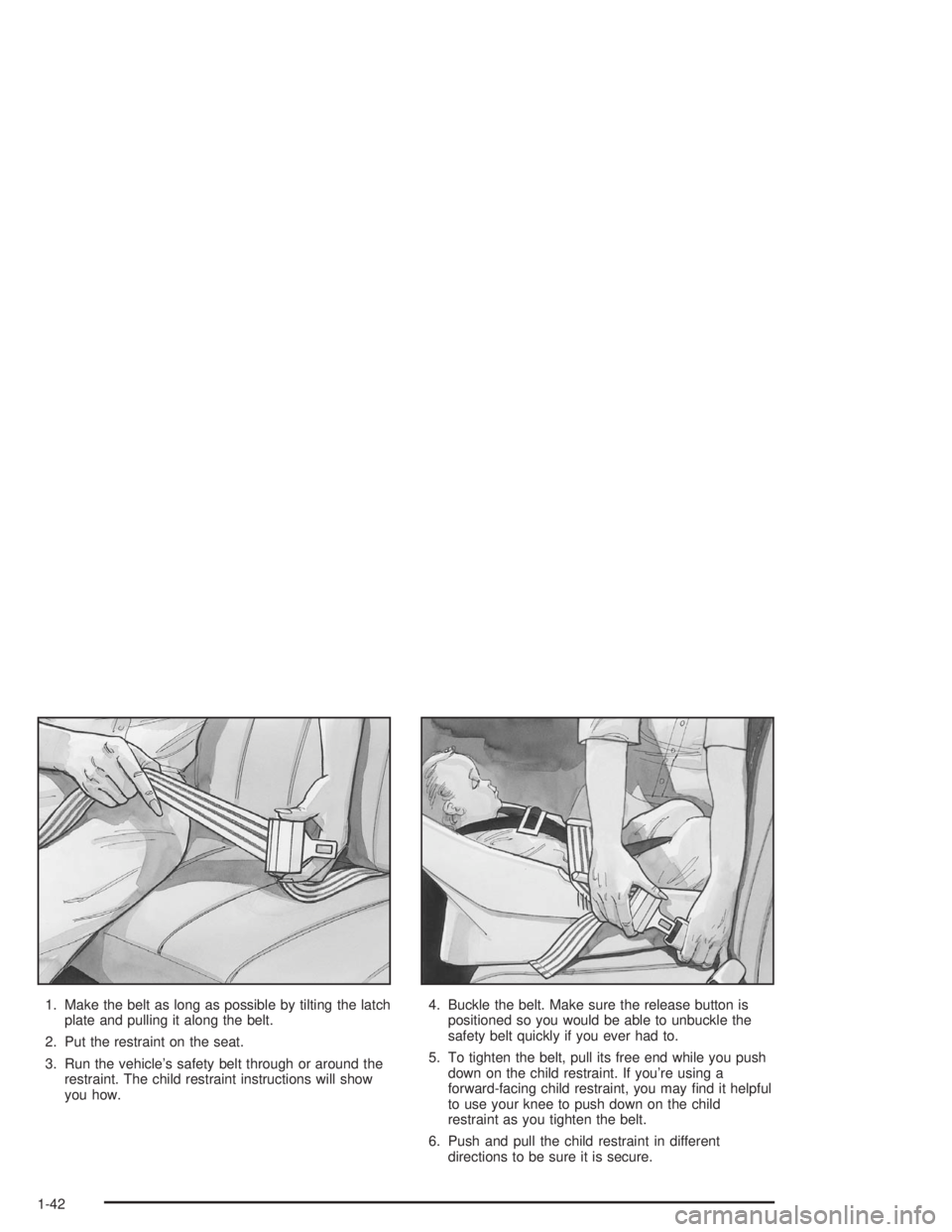
1. Make the belt as long as possible by tilting the latch
plate and pulling it along the belt.
2. Put the restraint on the seat.
3. Run the vehicle’s safety belt through or around the
restraint. The child restraint instructions will show
you how.4. Buckle the belt. Make sure the release button is
positioned so you would be able to unbuckle the
safety belt quickly if you ever had to.
5. To tighten the belt, pull its free end while you push
down on the child restraint. If you’re using a
forward-facing child restraint, you may find it helpful
to use your knee to push down on the child
restraint as you tighten the belt.
6. Push and pull the child restraint in different
directions to be sure it is secure.
1-42
Page 49 of 366

To remove the child restraint, just unbuckle the vehicle’s
safety belt. It will be ready to work for an adult or
large child passenger.
Securing a Child Restraint in the
Right Front Seat Position
Do not use a child restraint with an air suspension seat.
{CAUTION:
A child restraint cannot be secured properly in
an air-suspension type seat. This is because
an air-suspension seat is designed to move up
and down for an adult passenger. Don’t use a
child restraint in an air-suspension seat.
There is no top strap anchor in this position. Do not
secure a child seat in this position if a national or local
law requires that the top strap be anchored, or if the
instructions that come with the child restraint say that the
top strap must be anchored. SeeTop Strap on
page 1-38if your child restraint has one.
If your vehicle has a right front passenger air bag, there
is a switch on the instrument panel that you can use
to turn off the right front passenger’s air bag when you
need to secure a child restraint in the right front
passenger’s position. SeeAir Bag Off Switch on
page 1-55for more on this, including important safety
information.
1-43
Page 50 of 366
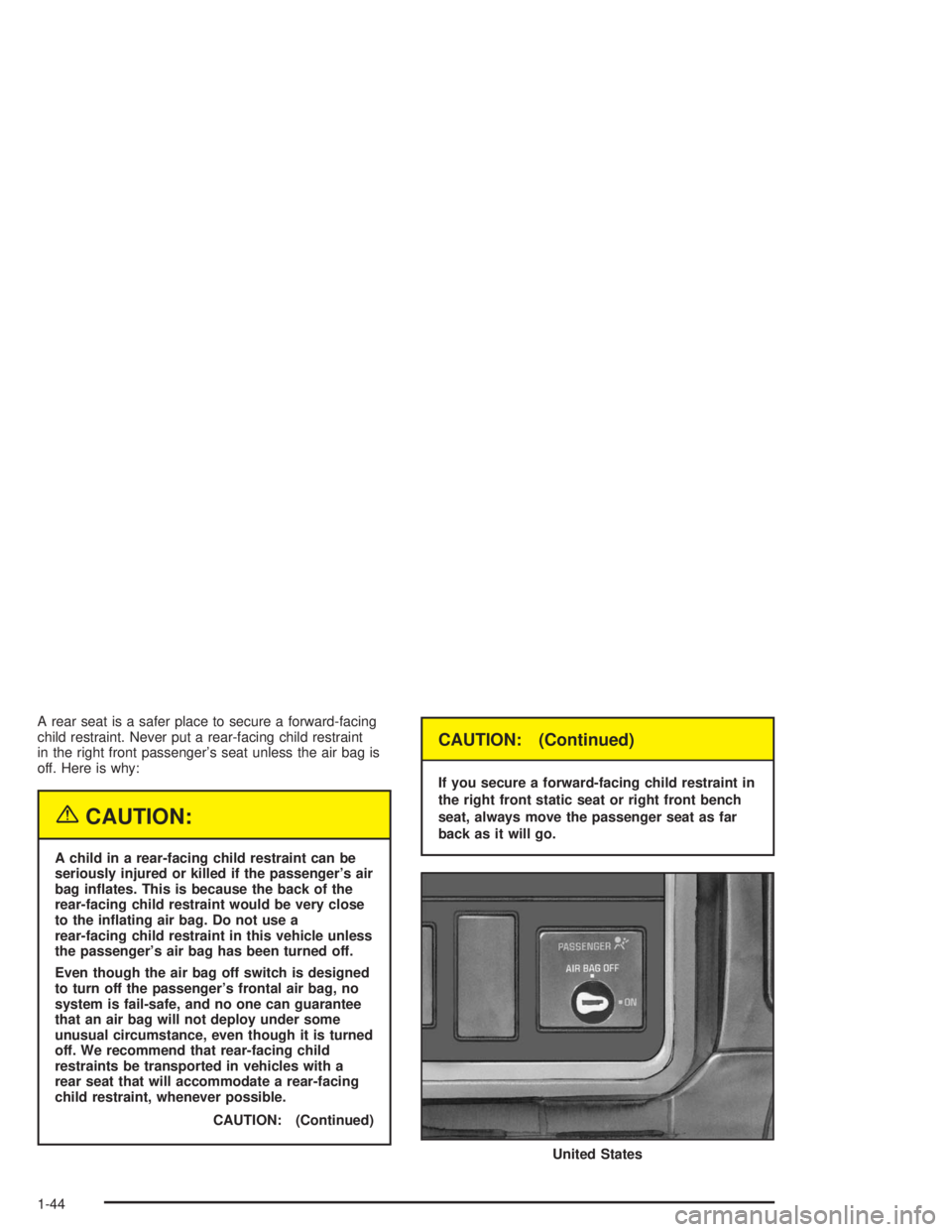
A rear seat is a safer place to secure a forward-facing
child restraint. Never put a rear-facing child restraint
in the right front passenger’s seat unless the air bag is
off. Here is why:
{CAUTION:
A child in a rear-facing child restraint can be
seriously injured or killed if the passenger’s air
bag in�ates. This is because the back of the
rear-facing child restraint would be very close
to the in�ating air bag. Do not use a
rear-facing child restraint in this vehicle unless
the passenger’s air bag has been turned off.
Even though the air bag off switch is designed
to turn off the passenger’s frontal air bag, no
system is fail-safe, and no one can guarantee
that an air bag will not deploy under some
unusual circumstance, even though it is turned
off. We recommend that rear-facing child
restraints be transported in vehicles with a
rear seat that will accommodate a rear-facing
child restraint, whenever possible.
CAUTION: (Continued)
CAUTION: (Continued)
If you secure a forward-facing child restraint in
the right front static seat or right front bench
seat, always move the passenger seat as far
back as it will go.
United States
1-44